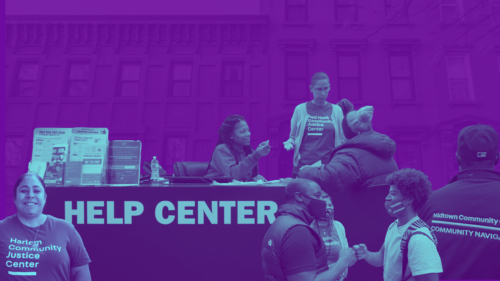These three challenges fuel the cycle of housing insecurity and justice involvement. Here’s how we can address them.
Housing needs and the justice system are deeply connected. Many people are already struggling to find stable housing when they come into court—nearly a third of participants in our alternatives-to-incarceration and Supervised Release programs, for example, reported at intake that they needed support with housing. Yet contact with the justice system too often exacerbates those underlying issues.
When they come together, courts, government agencies, community organizations, and tenants have the power to change that. Below are three challenges that fuel the cycle of housing insecurity and justice involvement, and how we can address them.
Challenge #1: People facing housing insecurity are at higher risk of coming into contact with the justice system.
Housing insecurity has ripple effects on every aspect of life. Staying in school, finding a stable job, caring for your family, and accessing services like mental health care can be significantly harder without a safe, stable home. All of those issues increase the odds that someone will come into contact with the justice system.
People experiencing homelessness are at especially high risk of being arrested, often due to the fact that they don’t have a place to carry out basic life functions. Lack of stable housing also plays a role in family court, where it can be a serious barrier to meeting court mandates and having a positive outcome.
What can we do?
Addressing housing needs early on, before they escalate into legal issues, is crucial. Housing resource centers like the ones we operate in Red Hook, Brooklyn, and Harlem provide support for people struggling to pay rent, get much-needed repairs, and navigate requirements—like lease adjustments and income reporting—that can be overwhelming. Even small investments in eviction prevention can prevent countless hardships for families down the road.
We also need alternative responses to people struggling with overlapping issues like homelessness, substance use, and mental illness. Outreach programs like Community First engage people on the streets and in shelters to build trust, offer hygiene kits and other life-saving supplies, and make connections to longer-term services. These interventions not only provide immediate support for those who often struggle to access it, but also reduce the chances that people will come into contact with the justice system in the first place.
Challenge #2: Traditional responses to crime often lead to more housing insecurity.
Being sent to prison or detained in jail while awaiting trial can cost a person both their job and their home. For others, especially those charged with low-level offenses, the legal process itself can be more disruptive than any official penalty—causing someone to miss work and potentially making it harder to pay their rent on time.
Court fines and fees can also cut into people’s finances, force them to choose between paying their bills or fulfilling their court obligations, and hurt their credit score—all of which can threaten someone’s housing situation. These costs aren’t borne just by people who have been charged with a crime, but also by their families, who can find themselves facing overwhelming financial burdens and even eviction while their loved ones navigate a lengthy legal process.
What can we do?
Instead of relying exclusively on punitive responses like fines and incarceration, we can invest in court programs that help people address the underlying issues that brought them into the system. Courts can work together with local service providers and community organizations to assess people’s needs and connect them to meaningful services in their own communities.
Apart from preventing the destabilizing effects that often come with the typical court process, these interventions can help people access resources that allow them to stay safely, affordably housed—from direct housing assistance to support with public benefits, employment, and financial literacy.
Challenge #3: People with a criminal record—especially those returning from incarceration—face a wide range of barriers to securing stable housing.
When someone returns from jail or prison, housing is often the main prerequisite to reintegrating into the community and avoiding another encounter with the system. Yet securing housing after incarceration can be an uphill battle, with up to 79 percent of formerly incarcerated people reporting that they have been denied housing due to a criminal record.
Since unmet housing needs make it more likely that someone will come into contact with the justice system, the lack of housing support for those returning to their communities can lead to a vicious cycle that makes it harder for people to rebuild their lives and leaves us all less safe in the long run.
What can we do?
Alternatives to incarceration that give people a chance to have their criminal charges reduced or dismissed by completing meaningful, community-based services can prevent the barriers to stable housing that are often triggered by a criminal record. But there are also ways to support people who are transitioning back from jail or prison into their communities.
Initiatives like our Bronx Community Solutions’ Reentry Anonymous Group connect returning citizens to services in housing, employment, child care, education, and more. And programs that combine affordable housing units with meaningful social services can ensure people dealing with complex challenges like serious mental illness can get access to the long-overdue care and support they need to build a more stable future.
